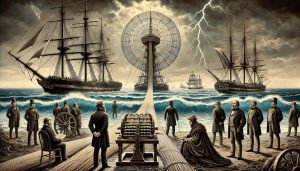In 1858, a monumental achievement revolutionized global communication—the successful transmission of the first public transatlantic telegraph message. This technological marvel connected Europe and North America with a single cable laid across the Atlantic Ocean, reducing the time it took to send a message from weeks to mere minutes. The event marked the beginning of a new era, shrinking the vast distances that once separated nations and laying the groundwork for the interconnected world we know today.
Before the transatlantic telegraph, communication across continents relied on ships carrying handwritten letters, a process fraught with delays and uncertainty. The idea of a telegraph cable beneath the ocean seemed like an impossible dream, requiring advances in both engineering and perseverance. The project, spearheaded by entrepreneur Cyrus West Field, involved multiple failed attempts, harsh weather conditions, and technological setbacks. But in August 1858, the cable successfully linked Ireland and Newfoundland, transmitting Queen Victoria’s congratulatory message to U.S. President James Buchanan—a moment heralded as a triumph for science and diplomacy.
The transatlantic telegraph transformed society, accelerating the exchange of ideas, news, and commerce. Governments could coordinate efforts more efficiently, businesses thrived with faster trade communication, and ordinary people marveled at the idea of near-instant connection across the globe. Though the original cable failed after a few weeks, subsequent improvements led to the establishment of a reliable transatlantic connection by 1866, solidifying the telegraph’s role as the forerunner of global communication networks.
Today, as we enjoy instantaneous digital communication, the story of the first transatlantic telegraph reminds us of the human drive to connect and innovate. It symbolizes the power of technology to bridge distances, foster collaboration, and build a more interconnected world—a vision that continues to inspire the progress of modern communication.

